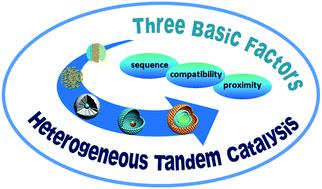当前位置:
X-MOL 学术
›
Mater. Chem. Front.
›
论文详情
Our official English website, www.x-mol.net, welcomes your
feedback! (Note: you will need to create a separate account there.)
Core–shell nano/microstructures for heterogeneous tandem catalysis
Materials Chemistry Frontiers ( IF 6.0 ) Pub Date : 2020-10-22 , DOI: 10.1039/d0qm00538j Zijian Wang 1, 2, 3, 4, 5 , Jian Qi 4, 5, 6, 7, 8 , Nailiang Yang 4, 5, 6, 7, 8 , Ranbo Yu 1, 2, 3, 4 , Dan Wang 4, 5, 6, 7, 8
Materials Chemistry Frontiers ( IF 6.0 ) Pub Date : 2020-10-22 , DOI: 10.1039/d0qm00538j Zijian Wang 1, 2, 3, 4, 5 , Jian Qi 4, 5, 6, 7, 8 , Nailiang Yang 4, 5, 6, 7, 8 , Ranbo Yu 1, 2, 3, 4 , Dan Wang 4, 5, 6, 7, 8
Affiliation

|
Tandem catalysis, featuring the transformation of reactants into target products through two or more steps of catalytic reactions in one single reactor, has become a growing research field, due to its advantages of economic benefit and environmental protection. Heterogeneous tandem catalysts have an advantage in industry owing to their easier separation from the catalytic system. We summarize three factors in designing an excellent heterogeneous tandem catalyst, including sequencing, proximity and compatibility of different catalytic sites. The above three factors can be satisfied by changing the packing style or designing the nano/micro structure of the heterogeneous tandem catalysts. It is worth noting that due to the unique structural features and physicochemical properties, advanced nano/microstructure materials can display some functions that cannot be obtained by a simple nanoparticle, especially in heterogeneous tandem catalytic reactions. In this review, firstly, the traditional heterogeneous tandem catalysts are introduced and further divided into multi-bed catalysts and randomly mixed catalysts, according to the packing style of the catalysts or catalytic sites. Secondly, we draw forth the characteristics of the nano/microstructure design of the tandem catalyst, and combine specific examples to illustrate its structural advantages. In this part, core–shell structures, including solid core–shell structures and heterogeneous hollow structures (yolk–shell structures and interlayer-hetero hollow multi-shelled structures (HoMSs)), are considered as ideal candidates for heterogeneous tandem catalysts owing to their excellent capacity to balance the aforementioned three factors. Meanwhile, the main preparation methods of interlayer-hetero HoMSs are also summarized. By summarizing the requirement of multistep catalysis, we conclude the new concept of the temporal-spatial order property for tandem catalysts as a perspective at the end of this review. This paper is helpful to get better insight into the design and application of well-defined heterogeneous tandem catalysts for both the energy and environmental fields.
中文翻译:

核-壳纳米/微结构用于非均相串联催化
串联催化以其在单个反应器中通过两步或更多步催化反应将反应物转化为目标产物为特征,由于其经济效益和环境保护的优势,已成为一个正在发展的研究领域。非均相串联催化剂由于易于从催化体系中分离而在工业上具有优势。我们总结了设计出色的多相串联催化剂的三个因素,包括测序,邻近性和不同催化部位的相容性。通过改变堆积方式或设计多相串联催化剂的纳米/微观结构可以满足上述三个因素。值得注意的是,由于其独特的结构特征和理化特性,先进的纳米/微结构材料可以显示出一些简单的纳米颗粒无法实现的功能,尤其是在异质串联催化反应中。本文首先介绍了传统的多相串联催化剂,并根据催化剂的堆积方式或催化部位将其进一步分为多床催化剂和无规混合催化剂。其次,我们提出了串联催化剂纳米/微观结构设计的特点,并结合具体实例说明其结构优势。在这一部分中,核-壳结构,包括固体核-壳结构和异质中空结构(蛋黄-壳结构和层间-异质中空多壳结构(HoMS)),由于其优异的平衡上述三个因素的能力,它们被认为是非均相串联催化剂的理想候选者。同时,总结了层间异构HoMS的主要制备方法。通过总结多步催化的要求,我们总结了串联催化剂的时空有序性质的新概念,作为本文结尾处的一个观点。本文有助于更好地了解能源和环境领域中定义明确的多相串联催化剂的设计和应用。我们总结了串联催化剂的时空有序性质的新概念,作为本文结尾处的一个观点。本文有助于更好地了解能源和环境领域中定义明确的多相串联催化剂的设计和应用。我们总结了串联催化剂的时空有序性质的新概念,作为本文结尾处的一个观点。本文有助于更好地了解能源和环境领域中定义明确的多相串联催化剂的设计和应用。
更新日期:2020-12-10
中文翻译:

核-壳纳米/微结构用于非均相串联催化
串联催化以其在单个反应器中通过两步或更多步催化反应将反应物转化为目标产物为特征,由于其经济效益和环境保护的优势,已成为一个正在发展的研究领域。非均相串联催化剂由于易于从催化体系中分离而在工业上具有优势。我们总结了设计出色的多相串联催化剂的三个因素,包括测序,邻近性和不同催化部位的相容性。通过改变堆积方式或设计多相串联催化剂的纳米/微观结构可以满足上述三个因素。值得注意的是,由于其独特的结构特征和理化特性,先进的纳米/微结构材料可以显示出一些简单的纳米颗粒无法实现的功能,尤其是在异质串联催化反应中。本文首先介绍了传统的多相串联催化剂,并根据催化剂的堆积方式或催化部位将其进一步分为多床催化剂和无规混合催化剂。其次,我们提出了串联催化剂纳米/微观结构设计的特点,并结合具体实例说明其结构优势。在这一部分中,核-壳结构,包括固体核-壳结构和异质中空结构(蛋黄-壳结构和层间-异质中空多壳结构(HoMS)),由于其优异的平衡上述三个因素的能力,它们被认为是非均相串联催化剂的理想候选者。同时,总结了层间异构HoMS的主要制备方法。通过总结多步催化的要求,我们总结了串联催化剂的时空有序性质的新概念,作为本文结尾处的一个观点。本文有助于更好地了解能源和环境领域中定义明确的多相串联催化剂的设计和应用。我们总结了串联催化剂的时空有序性质的新概念,作为本文结尾处的一个观点。本文有助于更好地了解能源和环境领域中定义明确的多相串联催化剂的设计和应用。我们总结了串联催化剂的时空有序性质的新概念,作为本文结尾处的一个观点。本文有助于更好地了解能源和环境领域中定义明确的多相串联催化剂的设计和应用。











































 京公网安备 11010802027423号
京公网安备 11010802027423号